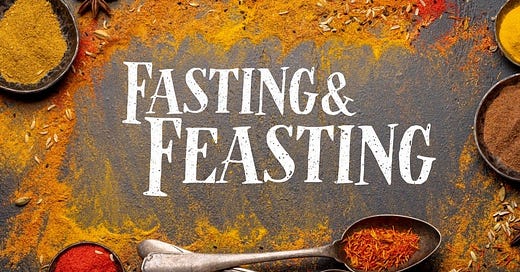Fast and feast
Occasional fasting can provide numerous health benefits, whether you fast for 24 hours or more, or whether you simply shrink your eating window. Early time restricted feeding seems to be particularly beneficial. This is where you eat all of your food from, say, 6:00 a.m. to 2:00 p.m. Following such a schedule has been shown to reduce visceral fat,1 an inflammatory form of fat that surrounds your abdominal organs, as well as improve insulin sensitivity, reduce blood pressure, and reduce oxidative stress, even when there is no associated weight loss.2
However, intermittent fasting should only be done intermittently. Chronically eating in a short feeding window can reduce testosterone levels in men (and probably women).3
On the flip side, there is nothing wrong with occasional feasting. My family and I have decided on a Sabbath-based approach. Once a week, we indulge in various delights. Sometimes this involves going out to a fancy restaurant, but most of the time it involves just staying home, making baked treats during the day, having a sumptuous supper at night, followed by an equally delicious dessert. It's a day of laughter and lovemaking, celebration and thanksgiving to God for all that he has provided.
Along these lines, I’m going to shamelessly plug my wife’s burgeoning little business: Little B’s Bakery, featuring healthier baked treats made from sprouted ancient grains,45678910 that have been sourdough fermented,111213141516 sweetened with honey,17 real maple syrup,1819 bananas, or dates, and enriched with goat butter202122 or virgin coconut oil.23242526 They are just as sweet, but nuttier and more intensely flavorful than any baked treat you’ve had in your life.
I’ll provide a link to the business once it’s officially up and running.
https://pubmed.ncbi.nlm.nih.gov/36220069/
https://pubmed.ncbi.nlm.nih.gov/29754952/
https://pubmed.ncbi.nlm.nih.gov/27737674/
https://pubmed.ncbi.nlm.nih.gov/37959020/
https://pubmed.ncbi.nlm.nih.gov/22474577/
https://pubmed.ncbi.nlm.nih.gov/37372622/
https://pubmed.ncbi.nlm.nih.gov/36111759/
https://pmc.ncbi.nlm.nih.gov/articles/PMC4488568/
https://pubmed.ncbi.nlm.nih.gov/29580479/
https://pmc.ncbi.nlm.nih.gov/articles/PMC10252758/
https://www.sciencedirect.com/science/article/abs/pii/B9780128023099000078
https://pmc.ncbi.nlm.nih.gov/articles/PMC5302357/
https://pubmed.ncbi.nlm.nih.gov/34256014/
https://www.sciencedirect.com/science/article/abs/pii/S0308814608002513
https://pubmed.ncbi.nlm.nih.gov/29473657/
https://onlinelibrary.wiley.com/doi/abs/10.1002/mnfr.201701054
https://pubmed.ncbi.nlm.nih.gov/37447382/
https://pubmed.ncbi.nlm.nih.gov/37877794/
https://pmc.ncbi.nlm.nih.gov/articles/PMC10469071/
https://www.sciencedirect.com/science/article/pii/S002203021200135X
https://pmc.ncbi.nlm.nih.gov/articles/PMC11215337/
https://pmc.ncbi.nlm.nih.gov/articles/PMC10806982/
https://pubmed.ncbi.nlm.nih.gov/30037019/
https://pmc.ncbi.nlm.nih.gov/articles/PMC3226242/
https://pubmed.ncbi.nlm.nih.gov/18549927/
https://bmjopen.bmj.com/content/8/3/e020167



